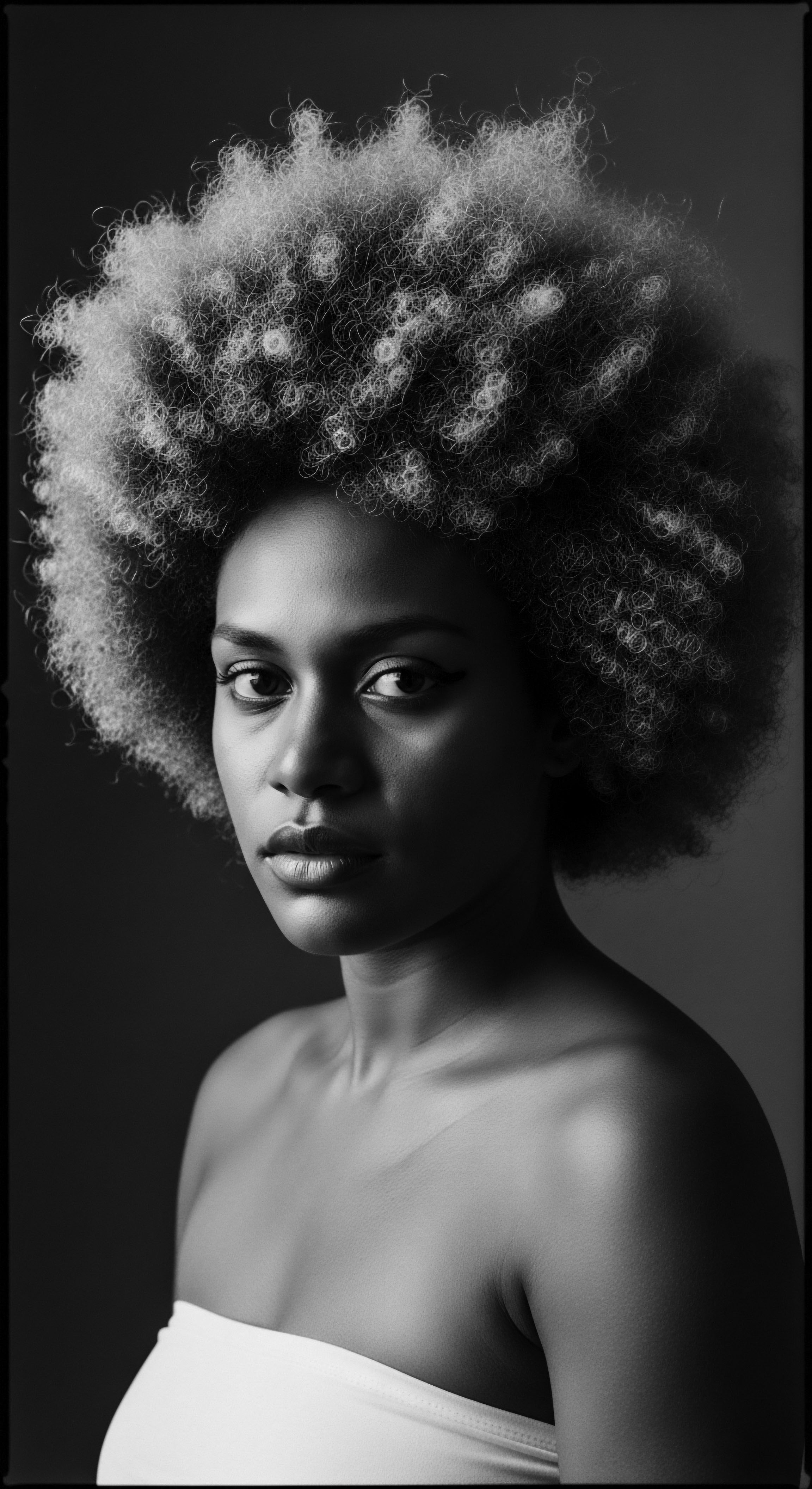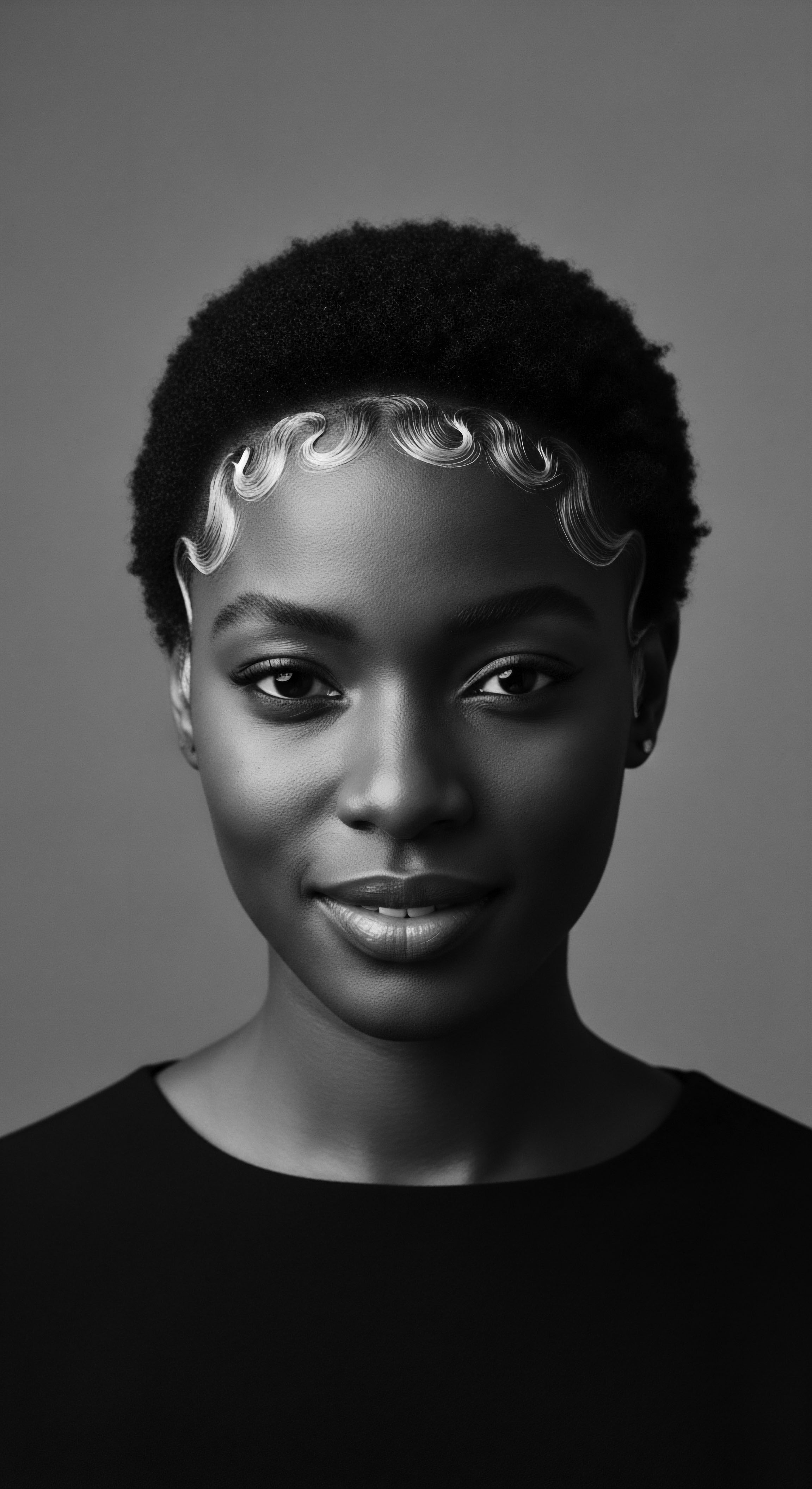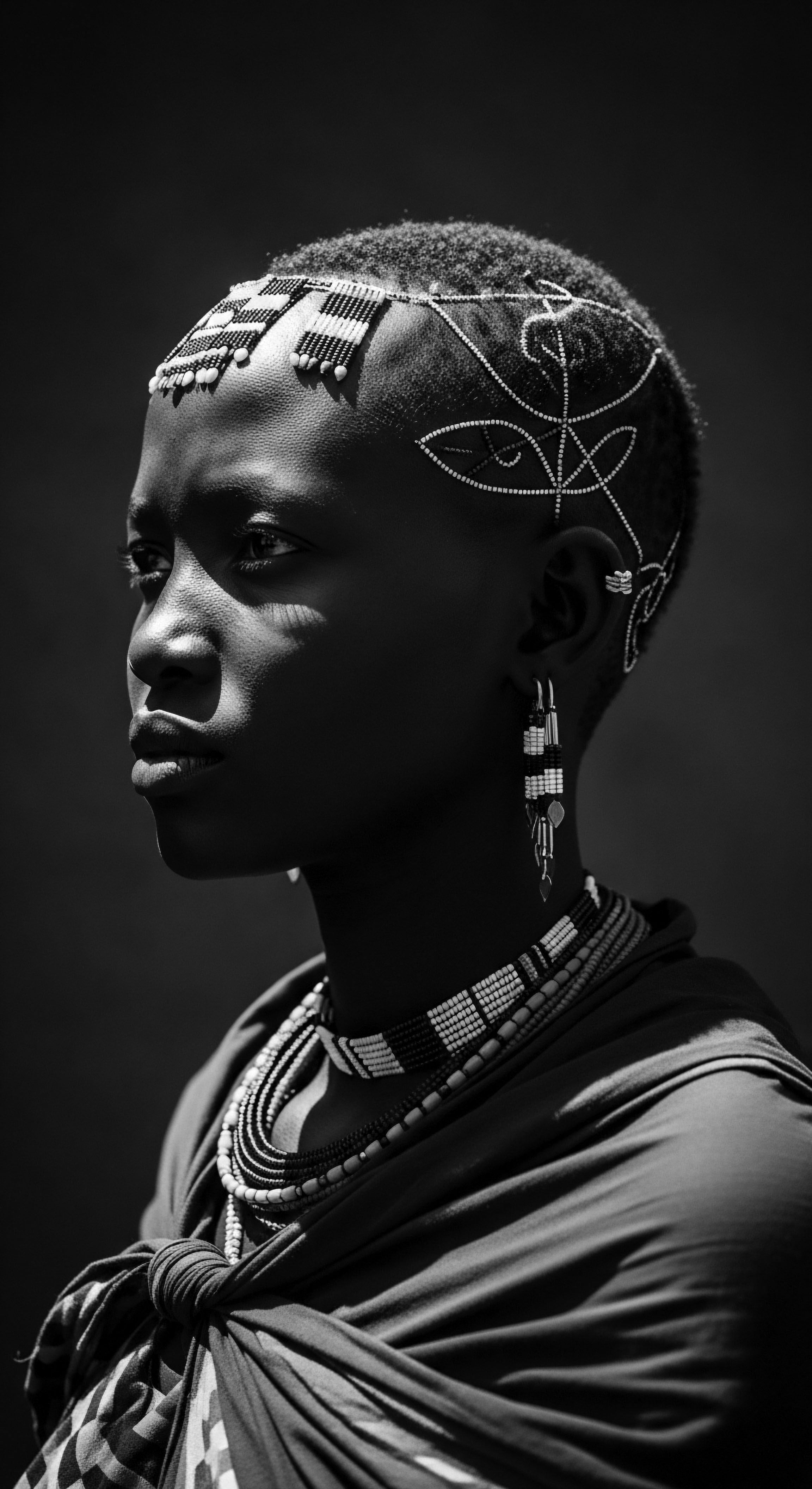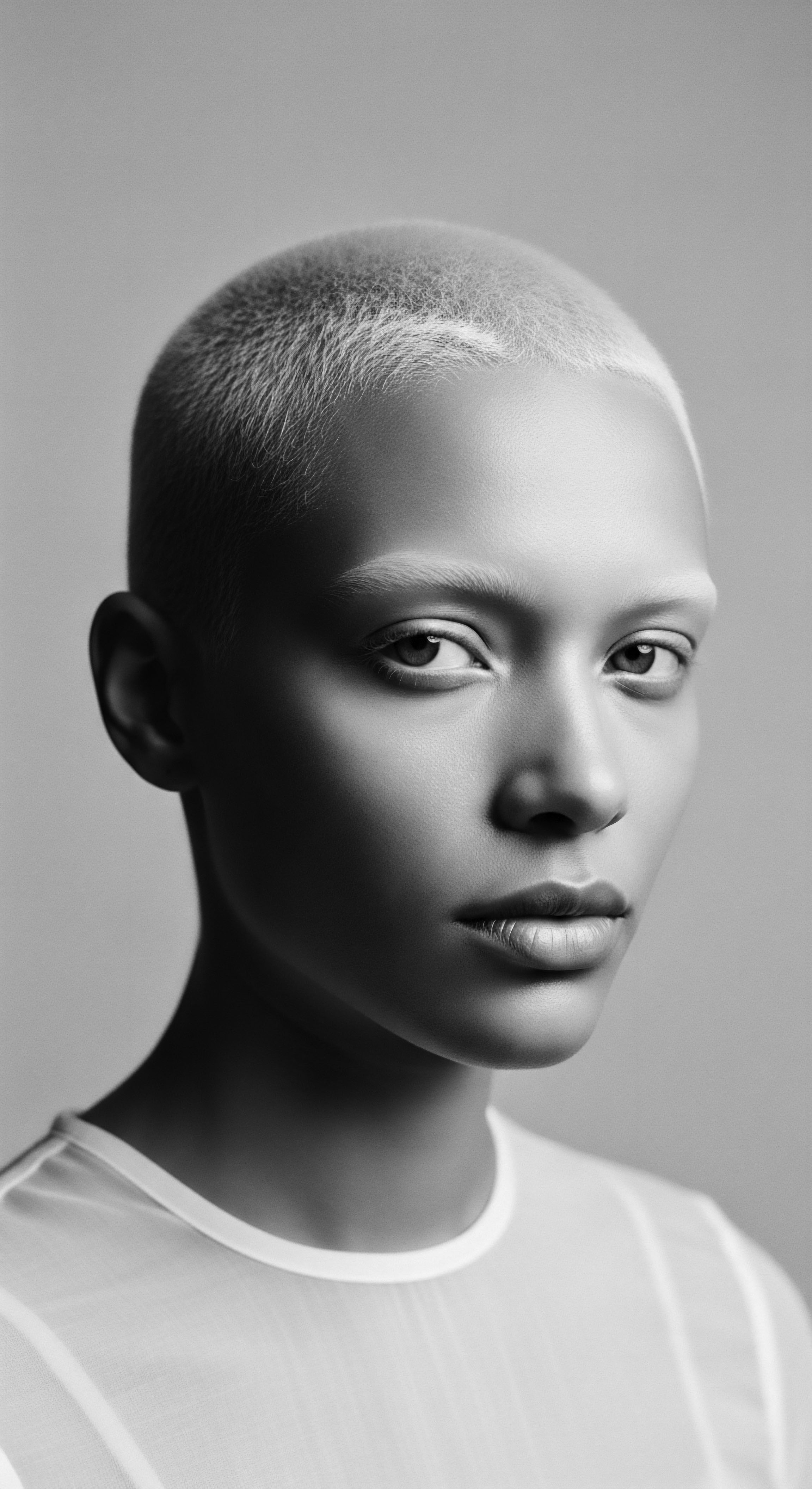
Roots
Consider the resilient helix of textured hair, a marvel of biological design and a profound marker of identity. For countless generations, strands have told stories, carried legacies, and mirrored the inner vitality of those who wore them. It asks us to look beyond superficial sheen, inviting a deeper contemplation of what truly fortifies each coil and kink. This inquiry draws us to the very earth, to seeds that sustained civilizations, and to the ancestral knowledge that saw nourishment as an interwoven tapestry of being.
Can the elemental sustenance found in ancient grains truly lend power to our textured hair? This question guides us back to the source, to the fundamental understanding of textured hair, viewed through a lens polished by the hands of our forebears.

Hair Anatomy and Ancestral Wisdom
The architecture of textured hair, with its unique elliptical shape and varied curl patterns, possesses an inherent strength, yet also specific points of vulnerability. Its helical structure, while creating glorious volume and body, also means more bends where the strand might be prone to breakage. At its core, each hair strand is a testament to protein, primarily keratin. This protein is assembled from amino acids, the building blocks supplied by the foods we consume.
Ancestral communities, long before the advent of modern nutritional science, understood this connection through observation and generations of accumulated wisdom. They witnessed the luster and vitality of hair nourished by diets abundant in life-giving provisions.
Our ancestors, living in intimate accord with the land, likely consumed diets far richer in micronutrients than many contemporary dietary patterns. Their food sources were often direct, unprocessed, and deeply rooted in local ecosystems. These indigenous food systems often included grains that today we classify as ancient.
These grains, largely unaltered by intensive modern breeding, retain a spectrum of nutrients often diminished in their conventional counterparts. Their consumption supported overall health, and by extension, the health of hair, skin, and nails, all of which are external reflections of internal well-being.
The enduring strength of textured hair finds its origins in the ancestral wisdom of nourishing the body from within.

Dietary Cornerstones of Early Communities
Across continents and through ages, communities of Black and mixed-race heritage have cultivated and relied upon diverse food sources. The grains that formed the backbone of these diets were not simply sustenance; they were cultural anchors, symbols of resilience, and silent partners in physical vigor. The nutritional compositions of these grains—their rich stores of protein, essential amino acids, vitamins, and minerals—would have provided the necessary foundational components for robust hair growth and structural integrity.
Consider the agricultural practices of West Africa, where grains like fonio have been staples for thousands of years, a testament to their adaptability and nutritional value. Fonio, with its remarkable amino acid profile, including methionine and cysteine, plays a role in the formation of keratin, the primary protein of hair. Similarly, in ancient Mesoamerican civilizations, amaranth was not only a food source but a sacred commodity, revered for its sustenance and believed to impart vigor.
Its protein content, particularly high in lysine, contributes to hair strength and overall tissue repair. These historical dietary patterns offer a tangible link between the foods our ancestors consumed and the inherent vitality expressed through their hair.

A Legacy of Sustenance
The early lexicon of textured hair, though perhaps not explicitly detailing micronutrient pathways, certainly held terms for hair that was strong, lustrous, and well-maintained. These descriptors indirectly attest to the holistic understanding of beauty, where external appearance was deeply tied to internal health. The practices of communal eating, of sharing bountiful harvests, were rituals that served to reinforce not only social bonds but also nutritional well-being, fostering environments where hair could truly flourish.
- Amaranth ❉ Revered by the Aztecs for centuries, recognized today for its exceptional protein and lysine content, contributing to hair structure and growth.
- Fonio ❉ A West African staple for millennia, noted for its methionine and cysteine, amino acids important for keratin formation.
- Teff ❉ A tiny, nutrient-dense grain central to Ethiopian diets, abundant in iron and calcium, both vital for hair growth and health.
The journey from elemental biology to ancestral practices reveals a harmonious connection. The fundamental understanding of textured hair’s needs aligns with the gifts of the earth. These grains, passed down through generations, offer a profound heritage, embodying the notion that true strength begins from the inside, a quiet power woven into the very fabric of life.

Ritual
Hair care, in many Black and mixed-race communities, transcends mere grooming; it becomes a ritual, a tender exchange, often steeped in the wisdom of elders. This involves more than external applications; it extends to the internal nourishment that fortifies each strand from its root. The historical consumption of ancient grains contributes to the very foundation of this internal strength, making external rituals more effective.
Consider the careful hands that braided hair, the oils gently applied, and the stories shared during these moments. These acts, outwardly focused on style and protection, were undergirded by the body’s internal state, influenced by generations of traditional diets.

The Inner Nourishment of Styling Heritage
Traditional styling techniques, such as various forms of braiding, twisting, and coiling, have always served a dual purpose ❉ aesthetic expression and practical protection. For these protective styles to truly serve their function, the hair itself needed inherent resilience. A strand weak from nutritional deficit would inevitably struggle, breaking under the tension of a braid or lacking the integrity to hold a twist. The daily and seasonal diets of our ancestors, rich in ancient grains, would have been silently supporting this foundational strength, providing the essential proteins, vitamins, and minerals required for durable hair.
The legacy of styling often involved community gatherings, where women shared techniques and passed down wisdom. Within these spaces, discussions might have included not only external practices but also the importance of specific foods that kept one strong and healthy. This deep appreciation for internal well-being as a precursor to external beauty has always been a subtle but profound aspect of textured hair heritage. The dietary patterns were not viewed in isolation, but as a part of a wider approach to self-care and communal vitality.
The enduring power of traditional hair rituals finds its deepest roots in the consistent nourishment derived from ancestral foodways.

Does Ancestral Diet Influence Textured Hair Structure?
The very structure of textured hair, its unique curl pattern, is genetically determined. However, the optimal expression of this genetic blueprint, its strength, elasticity, and resistance to damage, is heavily influenced by nutrition. The consistent supply of essential nutrients from ancient grains throughout generations would have contributed to the overall vitality of the hair fiber. Proteins, particularly those with a complete amino acid profile, are vital for keratin synthesis.
Ancient grains such as sorghum , widely cultivated across Africa, and millet , known for its hardiness, provided robust sources of plant-based protein. These grains, often ground into flours for porridges, flatbreads, or fermented beverages, offered a steady stream of building blocks for hair cells. This sustained internal support would have reduced susceptibility to breakage and brittleness, making hair more pliable and amenable to styling, reinforcing the connection between internal diet and external manageability.
Consider the practice of hair oiling or scalp massages, common across many cultures of the African diaspora. While the external application of oils provides moisture and scalp stimulation, the underlying health of the follicle, supplied by nutrients from the bloodstream, remains paramount. A diet rich in ancient grains would have provided the necessary vitamins and minerals to support healthy blood circulation to the scalp, ensuring follicles received optimal nourishment, enhancing the efficacy of these external rituals.

Tools of Tradition and Inner Resilience
The toolkit of textured hair care, from combs carved from wood to brushes made from natural fibers, serves to gently manipulate and style hair that is already robust. When hair lacks internal fortitude, these tools can exacerbate breakage. The strength of textured hair, therefore, is not solely a result of topical treatments; it reflects a deep internal well-being supported by a diet that has honored nature’s offerings for generations. This inner resilience allows for the successful execution of intricate protective styles, which themselves speak volumes about cultural identity and historical continuity.
| Ancient Grain Amaranth |
| Historical Significance Staple and sacred crop in Aztec civilization for over 8,000 years. |
| Nutritional Contribution to Hair Rich in protein, particularly lysine, which supports keratin structure and strength. |
| Ancient Grain Fonio |
| Historical Significance Cultivated in West Africa for millennia, often reserved for royalty; drought-resistant. |
| Nutritional Contribution to Hair Significant levels of methionine and cysteine, vital for hair growth and tissue repair. |
| Ancient Grain Teff |
| Historical Significance Central to Ethiopian cuisine for thousands of years, highly adaptable. |
| Nutritional Contribution to Hair Abundant in iron, calcium, and amino acids; supports oxygen transport to hair follicles. |
| Ancient Grain Sorghum |
| Historical Significance One of the oldest grains, a staple across African and Asian diets, highly drought-tolerant. |
| Nutritional Contribution to Hair Provides protein, B vitamins, and antioxidants, aiding overall hair cell metabolism. |
| Ancient Grain These grains illustrate how ancestral diets inherently supplied foundational building blocks for strong, vibrant textured hair, supporting traditional care practices. |
The narrative of textured hair styling is thus intertwined with the story of sustenance. The techniques, the tools, the very transformations of hair, all bear the invisible imprint of diets passed down through time. When we speak of styling heritage, we are also acknowledging the dietary heritage that has sustained its beauty through the ages.

Relay
The echoes of ancestral wisdom reverberate through scientific inquiry, affirming what was once understood through intuition and observation. Modern research increasingly illuminates the mechanisms by which dietary components influence the strength of textured hair. This section delves into the intricate relationship between ancient grains and hair vitality, drawing from studies that bridge historical practice with contemporary understanding. The exploration moves beyond the mere presence of nutrients to their specific roles in fortifying the hair strand, all viewed through the enduring lens of heritage.

How do Specific Ancient Grains Fortify Hair from Within?
The strength of textured hair is profoundly linked to the integrity of its keratin structure. Keratin, a fibrous protein, relies on a consistent supply of specific amino acids for its proper formation. Ancient grains, distinct from many modern, refined counterparts, offer a complete or near-complete profile of these essential amino acids. For instance, amaranth , a grain revered by ancient civilizations, provides a remarkably high protein content, notably rich in Lysine.
Lysine, an amino acid the human body cannot synthesize on its own, plays a critical role in collagen formation, which, while not a direct component of hair, supports the dermal papilla, the structure at the base of the hair follicle essential for hair growth. O’Brien (2019) explored the connection between traditional diets and physical markers, observing how dietary patterns could influence the chemical signatures within hair strands, signifying the direct link between consumption and physiological expression.
Another significant ancient grain is fonio , a West African staple with a legacy spanning millennia. Its unique amino acid profile includes considerable amounts of Methionine and Cysteine. Cysteine is a fundamental component of keratin, contributing to the disulfide bonds that grant hair its structural stability and resilience.
Methionine also plays a vital role in hair growth and tissue repair. These specific amino acids act as direct building blocks, allowing the body to construct robust keratin, which translates to a more resilient hair shaft, less prone to breakage and damage inherent to the intricate coils of textured hair.
Beyond amino acids, these grains are also sources of vital micronutrients. Teff , the diminutive grain from Ethiopia, stands out for its iron and calcium content. Iron is paramount for preventing hair loss and promoting growth, as it facilitates oxygen transport to hair follicles.
Calcium contributes to healthy hair and bone structure. These micronutrients, historically abundant in diets centered on such grains, underpin the holistic vitality of the hair, allowing it to withstand the demands of daily styling and environmental exposure.
Scientific understanding now mirrors ancestral knowledge, confirming that specific nutrients in ancient grains directly contribute to the internal strength and resilience of textured hair.

Exploring the Bioavailability of Ancient Grains for Hair Wellness
The true impact of dietary intake on hair strength lies not just in the presence of nutrients, but in their bioavailability—how effectively the body can absorb and use them. Ancient grains, often consumed as whole foods with their natural fiber and nutrient complexes intact, facilitate better absorption compared to highly processed alternatives. The co-occurrence of various vitamins and minerals within these grains acts synergistically. For example, the presence of Vitamin C in some ancient grains, like amaranth, aids in iron absorption, further amplifying its benefit for hair health.
Many traditional African diets, still practiced in various forms today, inherently relied on this synergistic nutritional approach. A scoping review by Musaba and colleagues (2025) highlighted that traditional African diets, rich in whole grains, legumes, and indigenous vegetables, offer high nutritional value and contribute to sustainable, healthy dietary patterns. This historical dietary wisdom provides a powerful framework for understanding how consistent, varied consumption of ancient grains would have translated into tangible benefits for hair over generations.

From Ancestral Plates to Modern Hair Fortification
The link between ancient grains and textured hair strength runs deeper than a simple list of nutrients; it encompasses a legacy of food as medicine, food as heritage. The conscious return to these grains in contemporary diets represents a reconnection to ancestral practices that intuitively understood the holistic nature of well-being.
A powerful illustration of this inherited dietary wisdom comes from the history of ancient civilizations. For example, the Aztecs, some 8,000 years ago, cultivated amaranth as a central dietary and ceremonial staple. They believed it possessed extraordinary powers, imbuing those who consumed it with great strength. Modern science now supports this ancient reverence, recognizing amaranth for having one of the highest protein contents of any plant, along with an abundance of essential amino acids, fiber, vitamins, and minerals vital for cellular health, including that of hair.
This historical example is not merely anecdotal; it embodies a sophisticated, albeit pre-scientific, understanding of nutrition’s role in physical fortitude, which would naturally extend to the strength and vitality of hair. The ancestral diet was, in essence, a silent, profound investment in hair strength, passed down through generations.
The integration of ancient grains into a modern diet offers a means to honor this lineage, providing hair with the foundational elements it needs to flourish. This is not about exoticism; it is about reclaiming fundamental dietary wisdom.
- Protein Richness ❉ Ancient grains like amaranth and fonio provide complete or near-complete protein profiles, supplying the necessary amino acids (like lysine, methionine, cysteine) for keratin synthesis.
- Mineral Density ❉ Teff, sorghum, and millet offer crucial minerals such as iron, zinc, and magnesium, supporting follicle health and preventing nutrient deficiencies that can lead to hair weakness.
- Antioxidant Support ❉ Many ancient grains contain antioxidants that protect cells, including those of the hair follicle, from oxidative stress, thereby preserving hair vitality.

Reflection
The conversation surrounding textured hair strength, viewed through the profound lens of its heritage, moves beyond mere aesthetics. It opens a dialogue with the past, revealing how ancestral wisdom, passed through culinary practices and daily rituals, holds keys to our present vitality. The ancient grains, once the silent providers of sustenance for our forebears, stand today as vibrant symbols of enduring knowledge. Their continued study and re-integration into our diets affirm a lineage of self-care and an unyielding connection to the earth’s nurturing bounty.
Each coil and strand of textured hair carries stories, not just of genetic blueprint, but of resilience cultivated through generations of intentional living. The strength we seek for our hair is not a new concept, but a return to elemental truths known to those who came before us. It is the wisdom of the earth, the intelligence of the body, and the continuity of tradition. In nurturing our hair with the gifts of ancient grains, we honor a heritage that reminds us that true radiance flows from within, a vibrant legacy woven into the very soul of a strand.

References
- Odele Beauty. (2020, December 21). The Benefits Of Amaranth For Hair, Skin And Health. Odele Beauty.
- WebMD. (2024, December 30). Amaranth ❉ Health Benefits & Nutrition. WebMD.
- Healthline. (2021, February 3). Fonio ❉ An Ancient Grain That’s Packed with Nutrients. Healthline.
- Hair Wash Day. (n.d.). Amaranth – ‘amaranthus’. Hair Wash Day.
- CleanO2. (2023, March 14). The Reason Why Amaranth (Velvet Flower) Is Great to Have in Your Shampoo. CleanO2.
- Akubugwo, E. I. Chike, O. O. & Ugbogu, A. E. (2007). Nutritional and Chemical Value of Amaranthus hybridus L. leaves from Afikpo, Nigeria. African Journal of Biotechnology, 6(24).
- Whole Grain 100. (2015, January 18). Fonio The Next Super Grain. Whole Grain 100.
- Eating More of This Grain Can Give You Thicker Hair, Softer Skin, and Help Fight Brain Fog. (2023, July 13). Eating More of This Grain Can Give You Thicker Hair, Softer Skin, and Help Fight Brain Fog.
- Terra Ingredients™. (n.d.). Fonio Health Nutrition | Nutrition, Benefits, Uses, and More. Terra Ingredients™.
- Terra Ingredients™. (n.d.). Health Benefits of Fonio. Terra Ingredients™.
- Healthline. (2017, January 28). 5 Benefits of Farro, A Healthy and Nutritious Ancient Grain. Healthline.
- Quinoaplex. (2021, October 11). This ancient grain could seriously strengthen your hair. Quinoaplex.com.
- Lakpah, V. & Bello, A. (2025, June 4). Top 10 African foods for healthy hair. DatelineHealth Africa.
- O’Brien, D. (2019, July 25). Diet of traditional Native foods revealed in hair samples. ScienceDaily.
- Musaba, J. Ngesa, R. N. & Chege, C. G. (2025, May 1). Africa’s contribution to global sustainable and healthy diets ❉ a scoping review. Frontiers.
